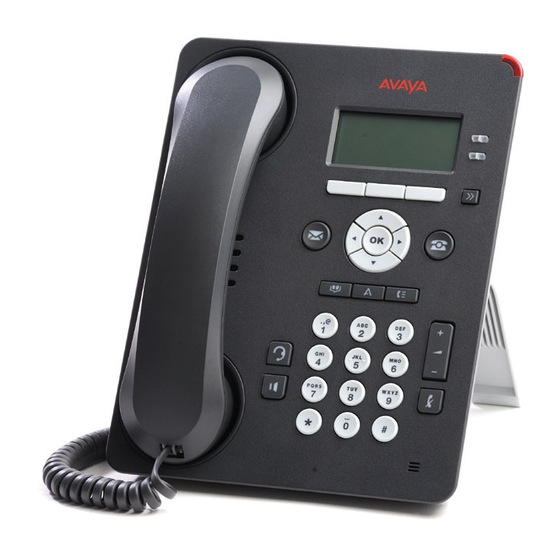Avaya 9601 Referensi Cepat - Halaman 3
Jelajahi secara online atau unduh pdf Referensi Cepat untuk Telepon Avaya 9601. Avaya 9601 8 halaman. Ip deskphone sip
Juga untuk Avaya 9601: Referensi Cepat (5 halaman), Referensi Cepat (3 halaman)

Note:
To automatically display the Phone screen when
you receive an incoming call, set the Phone
Screen on Ringing option to Yes.
Making a call
If you are not on a call, dial the number you want to call.
Use the Phone screen to view and manage calls. Press
Phone to view the main Phone screen. When the phone
displays the Phone screen, press Phone to move to the
top of the call appearance list.
1. Lift the handset, or press Speaker or Headset (if
applicable) or a line button for an available line.
2. Dial the number you want to call.
If you are on a mute call, you can select an available
call line appearance by using Up or Down arrows.
Making a call using edit dialing
Ensure that the Edit Dialing feature is enabled on your
phone.
Using the Edit dialing feature, you can edit the number
before actually dialing by using the Bksp softkey. Using
softkeys, you can change the number or character format
or backspace to "edit" the number before actually dialing
it. Using the Bksp softkey, you can edit the number before
actually dialing it.
1. On the Phone screen, enter the number you want to
call.
2. To edit the number, press Bksp to erase one
character at a time.
3. To change the character format, press the More > 123
softkeys.
4. Press Call.
Making a call with precedence
Use this procedure to make call with precedence level by
manually dialing the extension number or selecting the
desired extension from Favorites, History, or Contacts.
The call precedence level are categorized under the
following options:
• FO: Flash Override
• FL: Flash
• IM: Immediate
• PR: Priority
• Routine: Default value with lowest precedence.
Ensure that your extension is configured with the required
level of precedence and your administrator has enabled
the Multiple Level Precedence and Preemption feature.
Do one of the following:
Choice
Choice Description
Option
Use dial plan
Dial the prefix digits followed by the
configuration.
extension number.
Note:
The dial plan configuration is done on
the Local Session Controller (LSC) or
Enterprise Session Controller (ESC).
Use Priority
a. Press Priority softkey on the idle line
softkey.
appearance.
b. Select the precedence level on the
Precedence Selection screen.
c. Dial the desired extension.
Tip:
You can also select redial softkey
or autodial from the System
Number screen.
Note:
Configuration is done by setting the
parameter
ENABLE_PRECEDENCE_SOFTKEY.
Use Avaya
a. Press Avaya Menu button.
Menu.
b. Select Priority Call.
c. Select the precedence level from the
Precedence Selection screen.
d. Select the desired extension either
from the Contacts or History screen.
Routine is highlighted on the call session line if no
call is made within five minutes. Also, the precedence
level is valid for only one call session.
Making an emergency call
If your administrator configured emergency calling for your
phone, the Phone screen displays the Emerg softkey to
dial a preset emergency services number.
Note:
You can make an emergency call when your phone is
logged out only if your administrator configured this
feature for you. You can also make an emergency call
when you lock your phone.
Important:
During phone failover, when the phone switches
between system servers due to a system failure, the
Emerg softkey might not be available until your phone
connects to an alternate server. This process might
take a few seconds.
1. On the Phone screen, press Emerg.
2. Press Yes when the phone displays a prompt.
Some call servers call back to confirm the emergency
status. The phone automatically answers the incoming
call on the speaker by going off-hook.
3. To end the emergency call, press End Call.
Putting a call on hold
1. Press Phone to view the main Phone screen, if
necessary.
2. Select the active line you want to put on hold.
3. Press Hold.
Note:
The phone might display a hold timer when you
put a call on hold.
4. Press Resume, OK button, or the line button of the
held call to retrieve the call. Your system administrator
might have administered the Hold Recall feature,
which alerts you visually and with a priority ring to
remind you of a held call after a certain period of time.
Transferring a call
1. From the Phone screen, if the call to be transferred is
already not highlighted, press and select the call
appearance on which the call appears.
2. Press Transfer.
3. Dial the number if you know the number or call the
person from the contacts list or from the history list.
4. If your administrator configured unattended transfers
for your deskphone, you can hang up without
announcing the call. Otherwise, press Complete or
press OK.
Note:
Your deskphone might receive unanswered
transfers as recalled transfers. In this case, you
hear a priority ring that is different from a normal
ringtone and see the display message Return
next to the call.
Making an unattended transfer
An unattended transfer is when you transfer an active call
without establishing a call with the call-transfer recipient.
1. On an active call, press or tap the Transfer softkey.
The phone displays the Enter transfer destination
screen.
3
